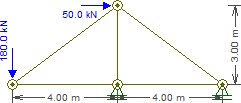This question is far simpler than it looks. Since it has four supports (RX and RY at A plus RY at D and E), it would seem to be statically indeterminate, but it actually isn't.
To see this, let's count the number of unknowns and the number of equations we have:
- 1 axial force for 10 bars = 10 unknowns
- 4 reactions ($A_x$, $A_y$, $D_y$, $E_y$) = 4 unknowns
- 2 equations ($\sum F_x = 0$, $\sum F_y = 0$) for each of 7 nodes = 14 equations
- Number of equations = number of unknowns, therefore we have an isostatic (statically determinate structure).
One way of solving this would be to create a system of 14 equations and solving it. This would work, but ain't nobody got time for that.
A much simpler way of solving this is by observing that this is actually two trusses, with the one to the left being supported by the one to the right by the node at $C$ (much like a Gerber beam).
So let's start by solving the truss to the left, placing a support at $C$ representing the effect of the other truss. Also, since we know that the horizontal force at $G$ will be fully absorbed by $A_x$, let's apply that force at $C$. Due to the Gerber-beam-esque behavior of this truss, we don't have to worry about the bending moment generated by shifting the force this way. After all, that bending moment wouldn't have crossed over the hinge at $C$ and the force itself would indeed have been transmitted via $C$, so there's no issue.

This is very straightforward, so I won't go into how to calculate the internal forces in each bar, but just calculate the reactions. It is clear that the results are $A_x = -50\text{ kN}$, $A_y = 60\text{ kN}$ and $C_y = 180\text{ kN}$.
We now move on to the rightmost truss, where we apply the fictitious value of $C_y$ (and notice that the horizontal force at $G$ is still there!):

This is also easy to solve for the reactions:
$$\begin{align}
\sum M_E &= -4D_y + 8\cdot180 - 3\cdot50 = 0 \\
\therefore D_y &= 322.5\text{ kN} \\
\sum F_y &= D_y + E_y - 180 = 0 \\
\therefore D_y &= -142.5\text{ kN}
\end{align}$$
Given the reactions, the structure is also easy to solve for the internal values, so that's left as an exercise for the reader.
Here's a computer model of the structure, as well as of the individual truss models. Notice I had to place a fictitious RX at $E$ for the isolated rightmost truss to be stable to horizontal forces, so ignore its horizontal reaction. This also alters the axial compression values for the bottom chord, so just subtract 50 kN from the compression in that model to make it align with the original structure.




